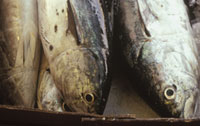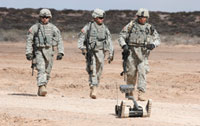PittCon brought analytical chemists from around the world to see the latest laboratory equipment with its increasing focus on miniaturisation. Neil Eisberg reports from Orlando, Florida
Miniaturisation is a part of everyday life, from consumer electronics to laboratory instrumentation. In the latter case, however, it enables users to ‘take the instrument to the sample, as opposed to taking the sample to the spectrometer,’ according to Richard Crocombe, Thermo Fisher Scientific. Such instruments will often consume less power and can be used by non-specialist operators since they are generally simple answer or ‘pass/fail’ units.
Teaching an old dog new tricks
But as Chris Brown, from Ahura Scientific, now part of Thermo Fisher Scientific, pointed out this is rather like teaching an old dog new tricks. Ahura’s handheld Raman spectrometer, for example, is one third the size, but offers eight times the speed and performance of the original unit from 2005.
Another aspect of instrument development is the increasing collaboration between potential users and equipment suppliers. In addition to a focus on applications, there is also a drive to make instruments easier to use, quicker to deliver results and higher throughput. New equipment must also be capable of integration into information management systems and upgradeable in the event of funding becoming more available to improve facilities.
Growth in the handheld spectrometer market is driven by economic and security factors, coupled with speed in the field, Crocombe said. This can range from rapid value determination, such as in recycling and mineral exploration, through safety/threat detection to purity/authenticity determination.
Developments within consumer electronics, he believes – ranging from the improvements in portable computing power, displays, light emitting diodes, batteries and low cost array detectors, such as in digital cameras – can all provide the relevant enabling technologies for the miniaturisation of analytical devices.
Recently developed technologies that enable the development of miniaturised spectrometers can be regarded as disruptive, Crocombe said – and instruments based on these technologies can find niches in new applications. ‘However, because the performance of these newer products can progress faster than their mature counterparts, or faster than the market’s requirements, they rapidly become competitive with these mature products, and eventually meet the performance requirements of the majority of the market,’ he added.
As an example of this rapid development, Crocombe looked at portable X-ray fluorescence (XRF) instruments, initially driven by regulations in the US and Europe over the presence of lead in paints and soil. More recently such portable instruments have found a role in detecting strontium in suspect ‘drywall’ building materials imported from China. Handheld XRF units are now comparable with bench top instruments in terms of performance, Crocombe said.
The development of such XRF and XRD instruments has depended on the use of chargecoupled devices (CCDs), according to Bradley Boyer from InXitu, which has based its instrument development on a requirement from the US National Aeronautical & Space Administration (NASA) for suitable detection devices for Mars exploration missions.
InXitu’s work has also resulted in equipment that can be used to detect counterfeit pharmaceutical actives, as well as for in situ testing of samples by geologists.
For counterfeit detection, the impetus was the requirement of US Customs officials to detect counterfeits at points of entry into the US so they could be destroyed rather than being returned for potential resubmission through another route. Boyer believes that ‘widespread knowledge about this type of detection will discourage “easy counterfeiting”’.
Ravi Kalyanaraman at Bristol-Myers Squibb estimates that up to 10% of the world’s drug supply is compromised with 20-30% of all drugs in South America, Africa and India being counterfeit, compared with less than 1% in the US. Kalyanaraman pointed out that Raman and near-IR spectral signatures can be used to identify and authenticate drug products ‘even if they include the actual API in the counterfeit product’. This non-destructive approach can be used for tablets, capsules and powders, even through the blister packs or vials in which they are packaged.
Kalyanaraman has used the handheld Ahura TruScan Raman and Polychromix Phazir NIR spectrometers, as well as the Bruker Multi Purpose Analyzer benchtop FT-NIR and Nexus Thermo benchtop FT-Raman units. Where he has experienced difficulties using the handheld units, for example, with coated tablets, the benchtop equipment has usually been successful, although he pointed out that tablet ‘burn’ can be a problem due to the higher energy levels employed.
Food safety and security receive a boost from new testing methods

Foodborne illness cost the US around $152m/year, according to a recent report, Health-related costs of foodborne illness in the US. At the PerkinElmer EcoAnalytix symposium, Darryl Sullivan pointed out that there are at least 76m reported food borne illnesses each year resulting in 325,000 hospitalisations and 5000 deaths/year in the US. The answer, he said, is increased and faster inspection and testing.
At PittCon, Agilent Technologies and the US National Center for Food Safety and Technology (NCFST) announced a collaboration to develop new scientific methods for food testing, with the goal of solving a range of persistent problems facing global food supply chains. Agilent will equip the NCFST lab in Summit-Argo. Illinois, with analytical chemistry and life science instrumentation with full service support, as well as providing training and applications support.
‘This is an opportunity to positively impact many peoples’ lives by giving researchers better ways of analysing foodborne illnesses and food quality on a significant scale,’ said Mike McMullen, president, Agilent Chemical Analysis Group. ‘We’re putting powerful analytical and biological tools into the hands of some very bright scientists from academia, industry and government, where their combined perspectives should produce creative solutions.’
The technology will allow NCFST to study chemical compounds of concern, said Jack Cappozzo, director, chemistry, NCFST, including melamine; aflatoxins; pesticides; antibiotic residues, such as flunixin and clenbuterol; and Clostridium botulinum toxin.
A 2010 study by the US Grocery Manufacturers Association and consultant A.T.Kearney estimates that economic adulteration and counterfeiting of food and consumer products could be costing the industry $10-15bn/year globally. To combat this problem, stringent EU regulations took effect on 1 January 2010 designed to eliminate illegal, unreported and unregulated fishing, as the world’s marine fish stocks come under increasing pressure from overfishing and environmental factors. A key driver behind this initiative is the need to verify that fish are being harvested from sustainable populations.
Agilent also launched its Fish Species Identification method that matches samples to a species DNA database that speeds and simplifies the use of DNA to identify fish species in food products. It can be used as a highly-accurate technique for the routine verification of seafood labeling and detecting species substitutions. The system works with fish that is fresh, frozen, dried, salted or minced, and also works with fish fins.
The system uses an Agilent DNA Fish Species ID Ensemble with an Agilent 2100 Bioanalyzer lab-on-a-chip system, and decoder software. The DNA analysis method is based on polymerase chain reaction-restriction fragment length polymorphism (PCRRFLP), developed by Campden BRI in the UK and said to be far more accurate and robust than existing protein-based tests. It also reduces the time needed to confirm species in food from days to hours, making the method useful to customs and import agencies.
Mike McMullen, president of Agilent Chemical Analysis Group, said: ‘Consumers and regulators increasingly demand foods that are harvested sustainably, and are not adulterated with species of lesser value. We’re delivering a tool to increase everyone’s confidence that fish served as halibut served at their local restaurants is really halibut.’
Another aspect of identifying if a food is what it says it is can be described as food or food chain provenancing – identifying where a food product comes from. As Jurian Hoogewerff, from the University of East Anglia, UK, pointed out this can provide a major challenge as, for example, in tracking the origin of a meat product such as steak. The steak sold in a UK supermarket might have come from beef cattle born in New Zealand, reared in Brazil, slaughtered in Argentina, butchered in South Africa and packed in the Netherlands.
The answer, Hoogewerff suggested, could be to use elemental and isotope ratio MS, which was the subject of the €19m EU TRACE project completed in December 2009. Many natural products contain a trace of the chemical composition of the environment where they were formed. Using different MS instruments, Hoogewerff explained that the chemical and isotopic signatures of regional climate (H and O isotopes), bioenvironment (C and N isotopes), geology (elements and S, Sr, Nd, Pb isotopes) can be recognised in natural materials. The TRACE project investigated if geo-bio-climatic profiles, from a set of food commodities with different grades of complexity from sites in Europe and Argentina, could be linked to the geo-bio-climatic environmental conditions at these sites and used to construct prediction models.
From the results, Hoogenwerff concluded that spatial elemental and isotopic profiling does work but that identification of specific production regions is not always possible as indistinguishable climatic and geochemical conditions can occur at very different geographical locations. As a result he said that elemental and isotopic profiling can be useful in answering specific compliance questions like ‘Can this wheat come from region A?’ but finding the origin of an truly unknown sample remains a challenge.
Military and civilian forensic science in the fast firing line

‘The forensic specialist needs to be able to work faster, cheaper and better, but usually we ‘can only choose two at a time’, he added. As an example of the type of device that is needed, he suggested the StarTrek Tricorder. ‘It may be far-fetched but everything on that show was far-fetched,’ he said, ‘including mobile phones and Bluetooth ear pieces’.
As well as civil forensic operations, the military also poses a considerable forensics requirement, in addition to the identification of explosives. As Salyard pointed out, while in the past an enemy sniper would have attracted an artillery or air strike, on today’s battlefield with its strict rules of engagement, as in Afghanistan, for example, a forensic specialist will be asked to identify the exact location of the sniper for an extremely focused attack and to verify that sniper's involvement afterwards. The timescale for this work is just seconds and minutes, he emphasised, compared with ‘almost infinite’ timescales for civilian investigations.
Salyards highlighted that the National Academy of Sciences report, Strengthening forensic science in the United States: a path forward, identified this increasing demand from the military. Some forensic disciplines are lacking research to support what he described as ‘fundamental and intuitive but unproven assumptions’, for example, that no two fingerprints are the same. In addition, he said the so-called ‘expeditionary environment’– military operations like those in Iraq and Afghanistan – demands instruments that are rugged and lightweight, providing further support for the increasing miniaturisation of common analytical equipment.
Which nose knows best?
While Bloodhounds are the favourite tracker dog in detective stories, Ken Furton at Florida International University is working on the development of instruments that can do the job of trailing and identifying suspects as well as man’s best friend. Although dogs do have shorter duty cycles and more variability than instrumentation, he noted, they are unsurpassed in terms of speed, mobility and precision. This therefore sets the standard and the challenge for developing appropriate equipment.
Before such development can begin, Furton outlined the work he has undertaken to understand how dogs identify specific substances, like drugs or explosives. He emphasised that, using solid phase microextraction (SPME) coupled with gas chromatography-mass spectrometry (SPME-GC/MS), it can be shown that, rather than the whole substance, dogs react to just one component. With cocaine, for example, Furton noted that dogs react to methyl benzoate; for the drug ecstasy, it is MDMA. Such specific odours can be used in prototype odour kits for training dogs, as well as instrument development.
Furton emphasised that odours have also been identified from common explosives including TNT-based explosives, NG-based explosives, plastic and tagged explosives, and smokeless powders. It is shown that that the combination of as few as six odorant mimics can represent a comprehensive explosive odour kit for the majority of high explosives.
A newer development is the use of human scent to determine if a specific individual was present or absent at a variety of locations. Using SPME-GC/MS the scent source has been identified by Furton’s research group as volatile organic compounds (VOCs), including aldehydes, ketones, acids and esters, carried by dead skin cells that are shed as so-called ‘rafts’. The chemical profiles obtained from one individual could be distinguished from individuals within a population when using specific correlation coefficients; however, the key question is: can a machine duplicate the ability of dogs?
Furton pointed out that in developing equipment, it is essential to consider the possible variables, including sample collection methods and population differences. It is also necessary to consider that dogs can ‘dismiss’ all other related odours, focusing on just one key molecule, he added: ‘Dogs can differentiate identical twins, can machines do that?.’





